Tom's Hardware Verdict
If you consider OLED gaming monitors to be a cut above, then the Corsair Xeneon Flex 45WQHD240 is a cut above that. With premium gaming performance, a stunning picture and unmatched immersion, it is one of the very best gaming displays you can buy at any price.
Pros
- +
Stunning picture with deep contrast and saturated color
- +
Huge screen completely envelopes the user
- +
Premium game performance with fast response and low lag
Cons
- -
HDR color a little off-hue
- -
Low pixel density
- -
Expensive
Why you can trust Tom's Hardware
When OLED panels first arrived, bendability was one of their promised features. Theoretically, one could have a TV or monitor that could bend or roll up. LG demoed a rollable television at CES in 2020 that rises from a cabinet. It’s available today in a 65-inch size for an eye-watering $100,000. And, of course, we have foldable phones available for sale.
However, Corsair is the first company to introduce a bendable computer monitor. It eliminates the issue of choosing between a flat or curved panel. With the Xeneon Flex 45WQHD240, you can have both. At 45 inches wide, 21:9 aspect ratio, it’s the largest ultra-wide I’ve seen yet among the best gaming monitors. The bend goes to 800R, which is a very small radius. It also has serious gaming cred with 240 Hz, Adaptive-Sync, HDR and wide gamut color. Let’s take a look.
Corsair Xeneon Flex 45WQHD240 Specs
| Panel Type / Backlight | OLED |
| Screen Size / Aspect Ratio | 45 inches / 21:9 |
| Curve radius: flat to 800R | |
| Max Resolution & Refresh Rate | 3440x1440 @ 240 Hz |
| G-Sync & FreeSync Certified | |
| 48-240 Hz | |
| Native Color Depth & Gamut | 10-bit / DCI-P3 |
| HDR10 | |
| Response Time (GTG) | 0.3ms |
| Brightness (mfr) | 450 nits SDR |
| 1,000 nits HDR | |
| Contrast (mfr) | 1,500,000:1 |
| Speakers | None |
| Video Inputs | 1x DisplayPort 1.4 |
| 2x HDMI 2.1, 1x USB-C | |
| Audio | 3.5mm headphone output |
| USB 3.1 | 1x up (type C), 4x down |
| Power Consumption | 61.5w, brightness @ maximum |
| Panel Dimensions (flat) | 41.7 x 22.5 x 12.4 inches |
| WxHxD w/base | (1059 x 572 x 315mm) |
| Panel Thickness | 0.2 inches (6mm) |
| Bezel Width | 0.4 inch (10mm) |
| Weight | 13.9 pounds (6.3kg) |
| Warranty | 3 years zero dead pixel |
| 3 years zero burn-in |
In the world of unique computer monitors, the Xeneon Flex is a standout. As an OLED, it joins a small and elite group of displays with fantastic contrast and rich color. The Flex has the same infinite dynamic range as other OLEDs I’ve reviewed and covers slightly under 100% of the DCI-P3 color gamut. With a few tweaks, it delivers reference-level accuracy and also offers a usable sRGB mode.
Though OLEDs aren’t known for high brightness, the Flex can hit 1,000 nits in HDR mode when showing small highlights. SDR brightness is lower, as is appropriate. In my tests, a 25% window measured around 437 nits, which is respectable.
Gaming cred comes courtesy of a 240 Hz refresh rate with Adaptive Sync. The Flex is certified by Nvidia and AMD for both G-Sync and FreeSync Premium operating over a 48-240 Hz range. It also has extremely low input lag. In my tests, it proved to be quicker than other 240 Hz monitors by a comfortable margin.
The big story is the bend, of course. The Flex is the first, and for the moment only, bendable computer monitor available. You can leave it flat and enjoy a vast screen perfect for productivity. Or you can bend it as tightly as 800R for immersive gaming. You can leave it anywhere between those extremes or just bend one side. It is, effectively, several monitors in one. The bend is accomplished manually with two handles that extend from the sides.
According to Corsair, the life cycle of the Flex is at least 10,000 bends, which in theory, would take many years to achieve. The warranty is three years for both zero dead pixels and zero burn-in. Pixel orbiting and refresh features are included to maintain the panel’s health while in standby mode.
Get Tom's Hardware's best news and in-depth reviews, straight to your inbox.
There’s a lot to see here, so let’s get unpacking.
Assembly and Accessories
The Flex is a one-unit display with an integrated stand. There’s no assembly required, nor can you remove the stand since it incorporates both inputs and controls. The box is a lift-off style, like a TV, that protects the contents with blocks of crumbly foam. A beefy 240-watt power supply and DisplayPort, HDMI, USB A-C and USB C-C are included.
Product 360
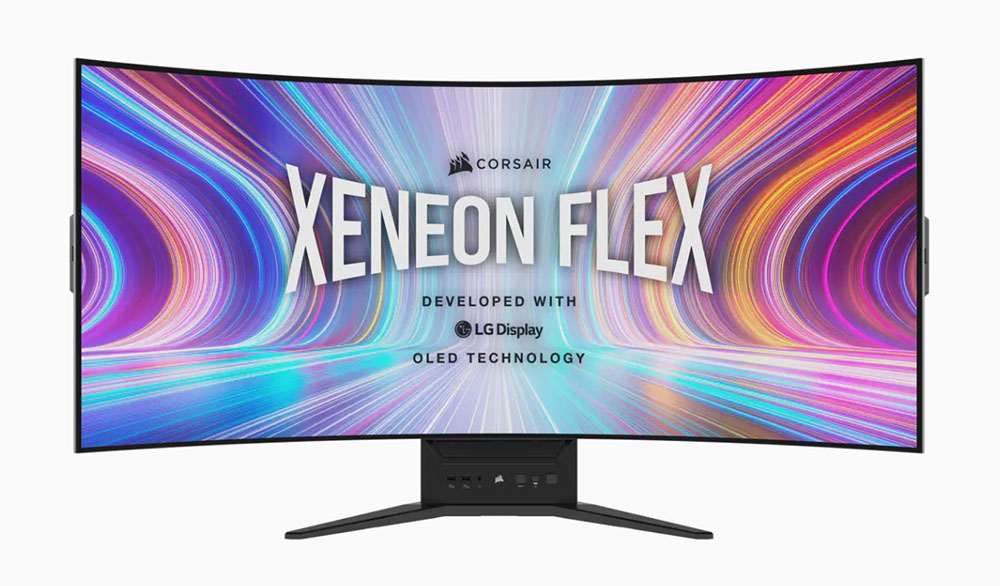
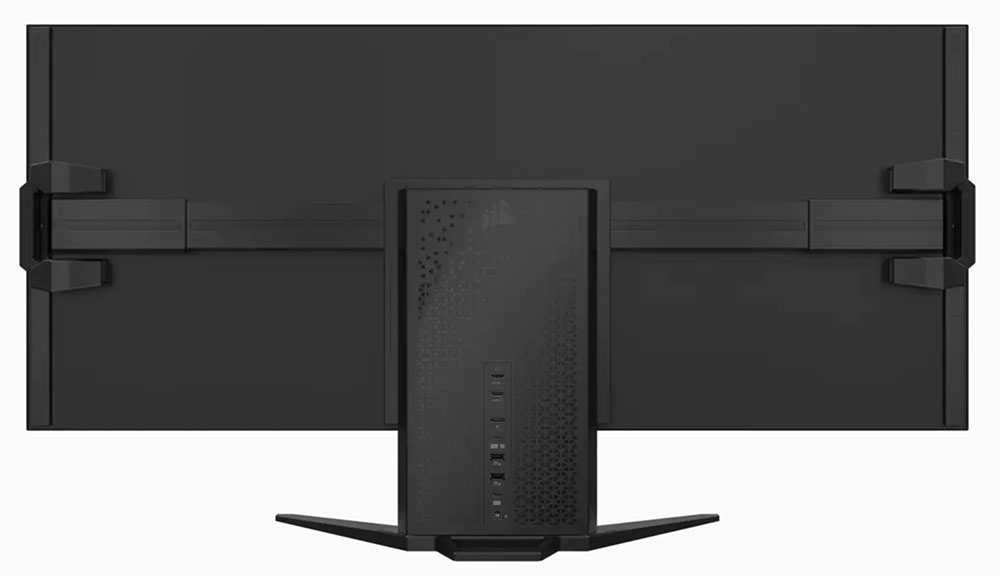
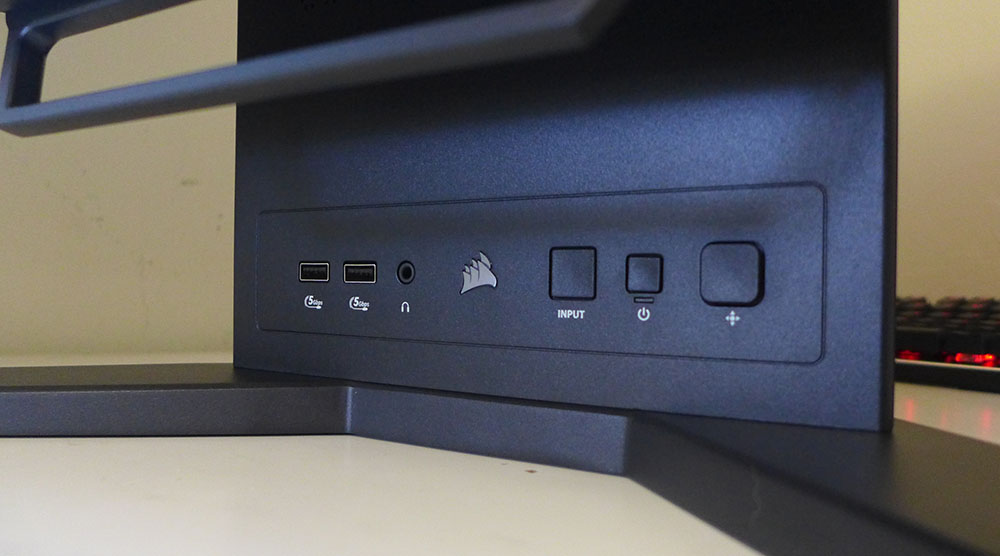

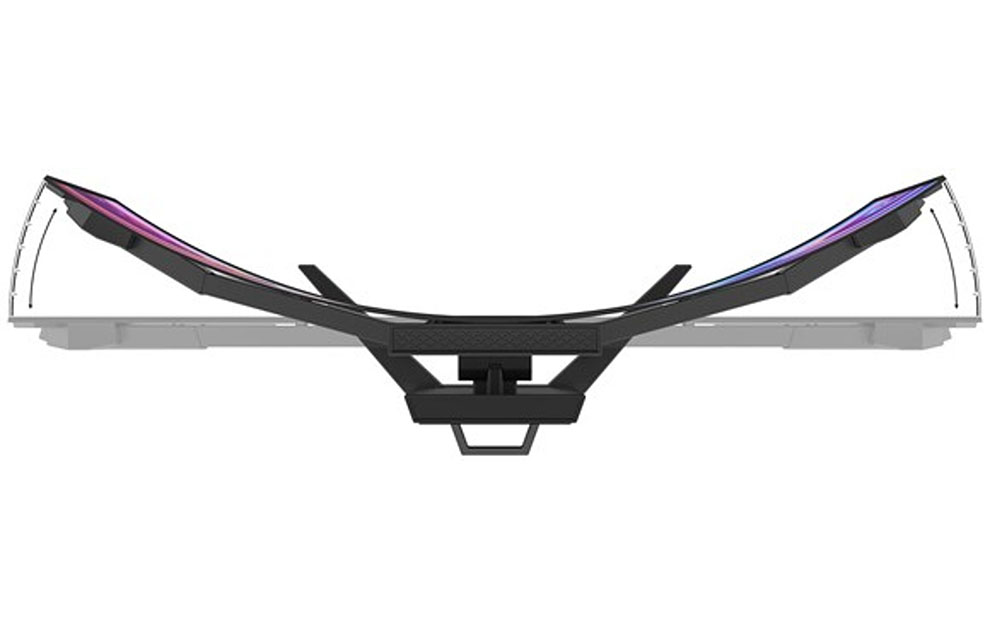
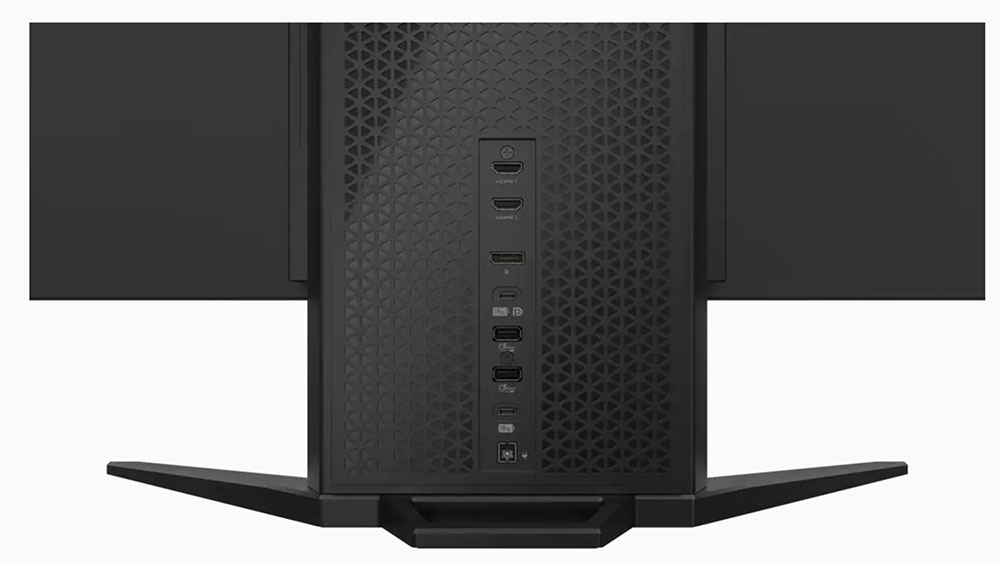
The Flex is an impressive sight once you find a spot big enough for it. Some room on the sides is required to fit the handles that slide out when you want to bend or unbend. My initial reaction was a bit fearful because it’s hard to wrap one’s mind around bending a computer monitor. The panel is only 6mm thick, but it has a prominent component bulge in the back and two stabilizing arms that manage the bending action. To bend, simply pull the handles. You can bend only one side if you wish. An audible click sounds when you’ve reached the limit of 800R. The Flex is so large that its maximum bend is just about right for gaming from a three- to four-foot viewing distance.
The build quality is certainly premium, with a solid metal base over a foot deep. Stability is not an issue. A bit of texturing adorns the back of the upright, which is quite wide. A metal handle sits at the bottom center, which is handy for tilting the screen. It comes forward seven degrees or back 15. There is no swivel or height adjustment.
WQHD resolution, or 3440x1440, is more commonly seen in 34-inch screens. At 45 inches diagonal, the Flex gives up some pixel density. The 83ppi is less than the more familiar 109ppi one sees in a 34-inch ultra-wide or a 27-inch 16:9 QHD panel. This means you don’t want to sit too close lest you see the pixel structure. The screen surface is also unusual for an OLED because it’s matte. Most are very shiny and easily show reflections, but the Flex bucks this trend.
The Flex’s panel and stand are a single unit that cannot be disassembled. The controls are on the front beneath the screen and include an input selector, power toggle with LED, and a joystick for menu control. Two USB ports and a headphone jack are also provided, which is very convenient. There are no built-in speakers. In the back, there are two HDMI 2.1 inputs, a DisplayPort 1.4, a USB-C video and a second USB-C for peripherals. The screen sits a little low for me to get it perfectly vertical without a small stand underneath.
OSD Features
The OSD is completely text-based, with just a small Corsair graphic in the upper left corner. Pressing the joystick summons the menu. You can also go right to the input selector with a press of the Input key or a right click. Up selects brightness, Left adjusts volume, Down is image mode and Right is input.
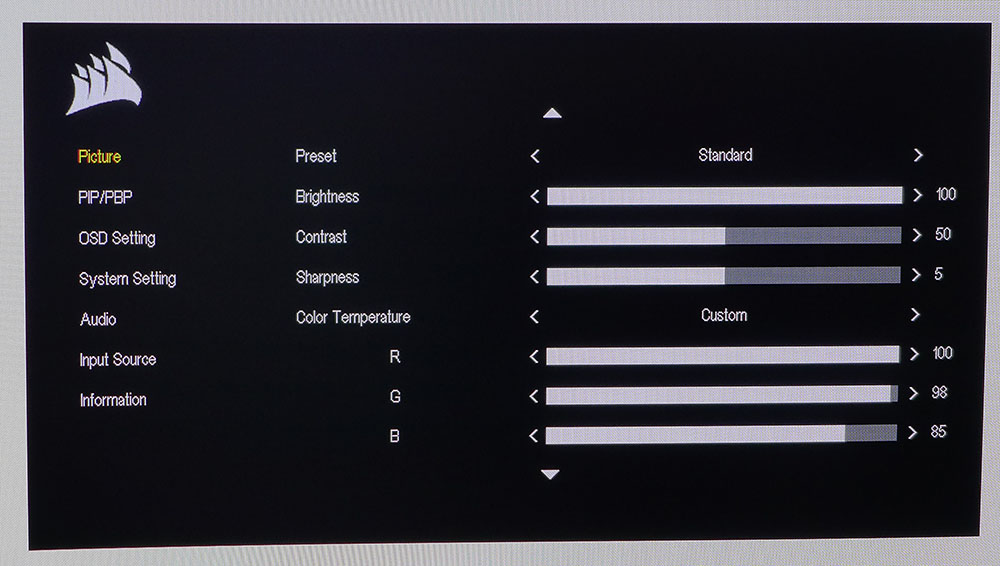


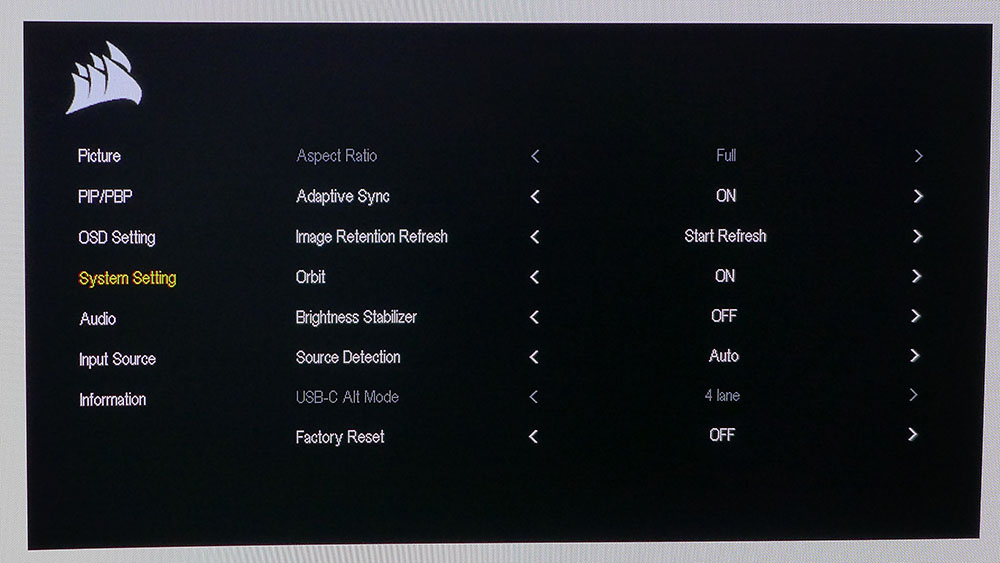
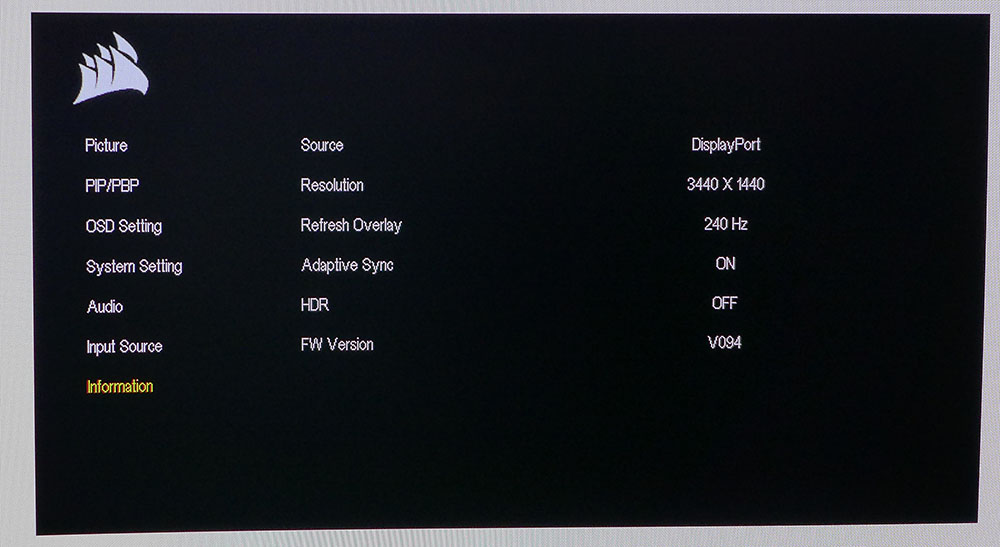
The Flex has six image presets, including Standard, which can be calibrated using the DCI-P3 gamut and sRGB, which employs the smaller color space. Unlike most monitors, the Flex’s sRGB mode can be independently calibrated, which is great for professionals who need reference quality for both color standards. You also get three color temperature presets, a custom mode, and three gamma options. Refresh Overlay is a frame counter, and you can create your own aiming point with different shape combinations shown in the second photo above.
A monitor this large is perfect for PIP and PBP functions, which allow viewing two sources at once. The Flex can easily replace two monitors with its vast screen area.
System Setting lets you toggle Adaptive-Sync on and off and manage the panel maintenance options. A pixel orbiter shifts the image up and down to prevent burn-in. You’ll never notice it in action. I stared at the screen for quite a while and could barely see anything happening. The Refresh option works while the Flex is in standby mode. Corsair warrants the Flex for three years against burn-in, so it is confident in these features. In my own experience, I have seen no burn-in on my two-year-old LG OLED TV.
Corsair Xeneon Flex 45WQHD240 Calibration Settings
The Flex has a factory-certified calibration, but I found some improvement with adjustments. The RGB sliders work precisely and allowed me to calibrate the Standard and sRGB modes separately. I could then switch back and forth between them at will. Gamma and color tracking were very good out of the box. I’ve provided my settings below.
There are no adjustments in HDR mode, but I found solid grayscale tracking there with good color saturation.
| Picture Mode | Standard - sRGB |
| Brightness 180 nits (Full field) | 100 |
| Contrast | 50 |
| Gamma | 2.2 |
| Color Temp User | Standard - Red 100, Green 98, Blue 85 |
| sRGB - Red 92, Green 94, Blue 100 |
Gaming and Hands-on
It’s hard to experience a monitor like the Flex and not lapse into an adjective stream where I spend hours coming up with ways to describe it in as many words as possible. Rather than bore you with that, I’ll just say that there’s absolutely nothing like it.
First is the size. I’ve reviewed lots of ultra-wide monitors. Most are 34 inches diagonal and provide a decent wrap around the viewpoint. 49-inch mega wides wrap more but lack height which can take the user a bit out of the experience. The Flex, with its 45-inch screen and 800R curve at full bend, takes immersion to another level. Nothing else can compare, nothing.
As far as bend versus flat, I found myself going back and forth a few times, then settling on bent. Most of my work happens in the center of the screen, so the bend isn’t distracting when editing a Word document. For spreadsheet tasks, it’s nice to see all the numbers without too much scrolling. Graphics editing is best with a flat screen. Then you can properly judge proportion and perspective. The Windows desktop was bright and vivid in the Standard picture mode with true blacks and bright but not harsh highlights. I turned down the brightness to 75% at night, but l left it at 100% during the day.
The Flex’s gaming prowess is tremendous. Input lag is low enough to be imperceptible. Screen response is free of any visible blur. Precision movement is this monitor’s forte. Wading through monsters in Doom Eternal’s horde mode was an addictive experience. I literally could not stop playing until my chihuahua finally demanded her dinner. The Flex drew me in completely. You will need to keep a timer or alarm clock handy to remind you when it’s time to eat.
And like other OLED panels, it plays more smoothly at lesser frame rates. I saw around 160fps in Call of Duty WWII, but it was as good or better than an LCD running over 200fps. Of course, the image was stunning with its rich color, true blacks and deep contrast. Though pixel density is relatively low, the picture’s dynamic range erases any perception of pixel structure.
The Flex is one of the very best gaming monitors I’ve experienced. It fits my skill level and style of play which is casual at best. It will appeal to a wide variety of players of all abilities right up to competition professionals.
MORE: Best Gaming Monitors
MORE: How We Test PC Monitors
MORE: How to Buy a PC Monitor: A 2022 Guide
MORE: How to Choose the Best HDR Monitor
Current page: Features and Specifications
Next Page Response, Input Lag, Viewing Angles and Uniformity
Christian Eberle is a Contributing Editor for Tom's Hardware US. He's a veteran reviewer of A/V equipment, specializing in monitors. Christian began his obsession with tech when he built his first PC in 1991, a 286 running DOS 3.0 at a blazing 12MHz. In 2006, he undertook training from the Imaging Science Foundation in video calibration and testing and thus started a passion for precise imaging that persists to this day. He is also a professional musician with a degree from the New England Conservatory as a classical bassoonist which he used to good effect as a performer with the West Point Army Band from 1987 to 2013. He enjoys watching movies and listening to high-end audio in his custom-built home theater and can be seen riding trails near his home on a race-ready ICE VTX recumbent trike. Christian enjoys the endless summer in Florida where he lives with his wife and Chihuahua and plays with orchestras around the state.
-
helper800 We can pick flat or curved and save 50%... I don't get the niche for this product other than, "Look at my monitor, it has two arbitrary modes of rest."Reply -
ThatMouse Very happy with my $250USD - 32" IPS 2560x1440 165Hz monitor while you guys spend all your money.Reply -
helper800 Reply
As an earlier adopter of 1440p at 165hz I paid nearly 600 dollars for it, but this is not a apples to apples comparison, because our monitors are likely substantially different when it comes to response time, perceived blur, brightness, and features.ThatMouse said:Very happy with my $250USD - 32" IPS 2560x1440 165Hz monitor while you guys spend all your money. -
Pollopesca Who is this for? I cant think of a use case for such a feature... I've never sat in front of my curved display and thought to my self "man, I wish I could bend this."Reply -
Sarah Jacobsson Purewal Reply
lol, yeah, of all the things i wish my monitors could do...this is not really high on the list. or...on the list.Pollopesca said:Who is this for? I cant think of a use case for such a feature... I've never sat in front of my curved display and thought to my self "man, I wish I could bend this." -
kjfatl Reply
The main reason for this feature could be "lower shipping cost". Instead of making an extra $300 on the curved monitor, the supplier can make $305 extra. It's not a big deal now, but is will be when the price drops to $199.Pollopesca said:Who is this for? I cant think of a use case for such a feature... I've never sat in front of my curved display and thought to my self "man, I wish I could bend this." -
DavidLejdar Reply
Some users may enjoy the option to switch between flat for work and curved for gaming. Additionally, there may be the argument that for a movie night with several persons, a flat screen is a bit better for the persons sitting on the sides of the couch. And there also is the issue that when someone has a multiple display wall-setup, a curved display may not be that great to have as a side display - and having a display with some flexibility about where it can be used in such a setup, that may be appealing.Pollopesca said:Who is this for? I cant think of a use case for such a feature... I've never sat in front of my curved display and thought to my self "man, I wish I could bend this."
Not saying that it would be enough of an argument for me personally to spend that much on it. Just naming some examples of what some may find quite nice about it. -
Sleepy_Hollowed I was about to do backflips when it said that it had low pixel density (something like 2560 X 1080 or 2560 x 1200), but alas, that's way too high for mortals.Reply
I think it might be priced for the target audience, people who can just buy a top of the line GPU, or someone making content for both flat and curved displays, to quickly test them, though I don't know how much it might last doing that constantly. -
sgtkeebler Dang, I really want this monitor 4k at 240 refresh rate, and it also curves too. Sign me up.Reply